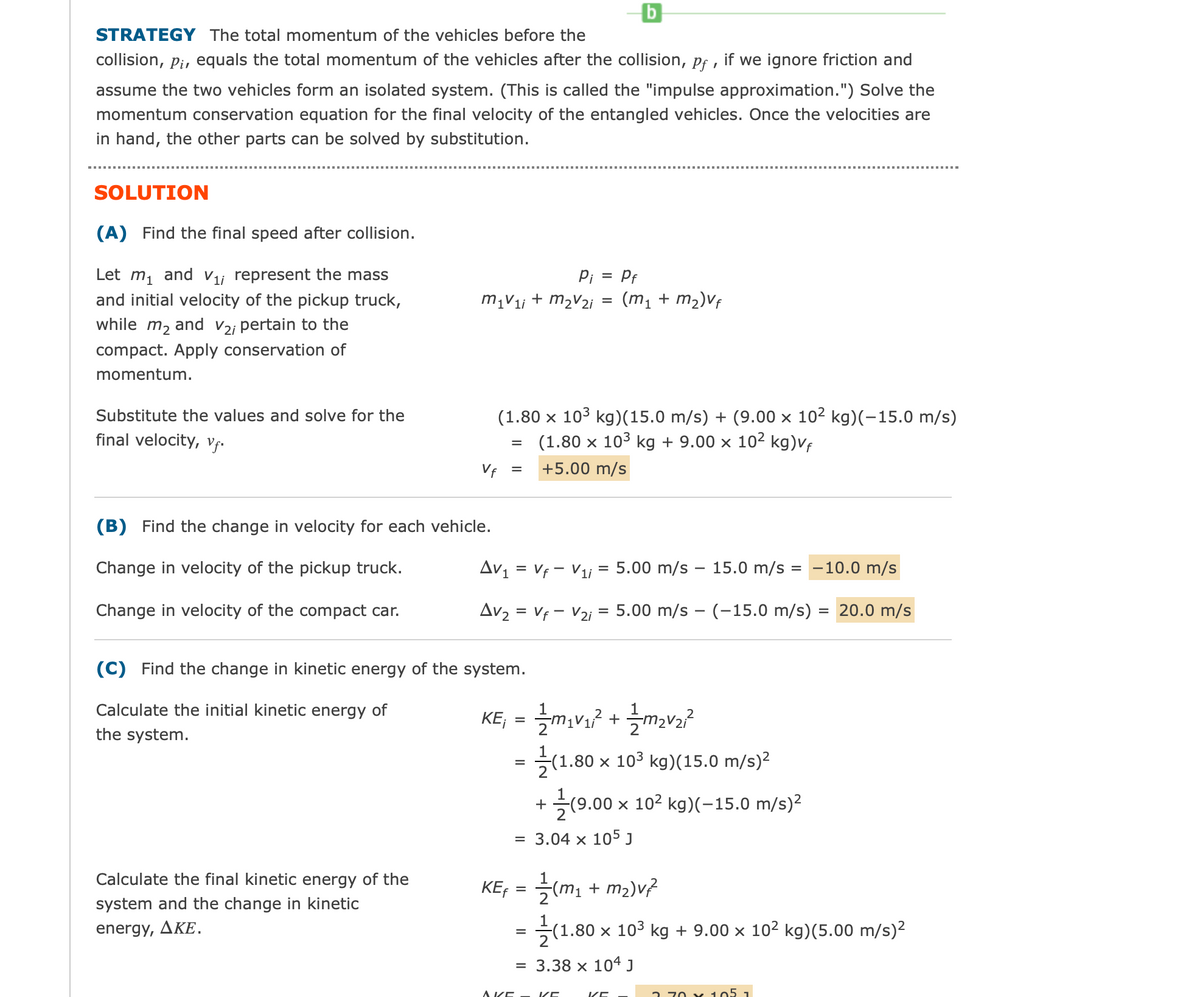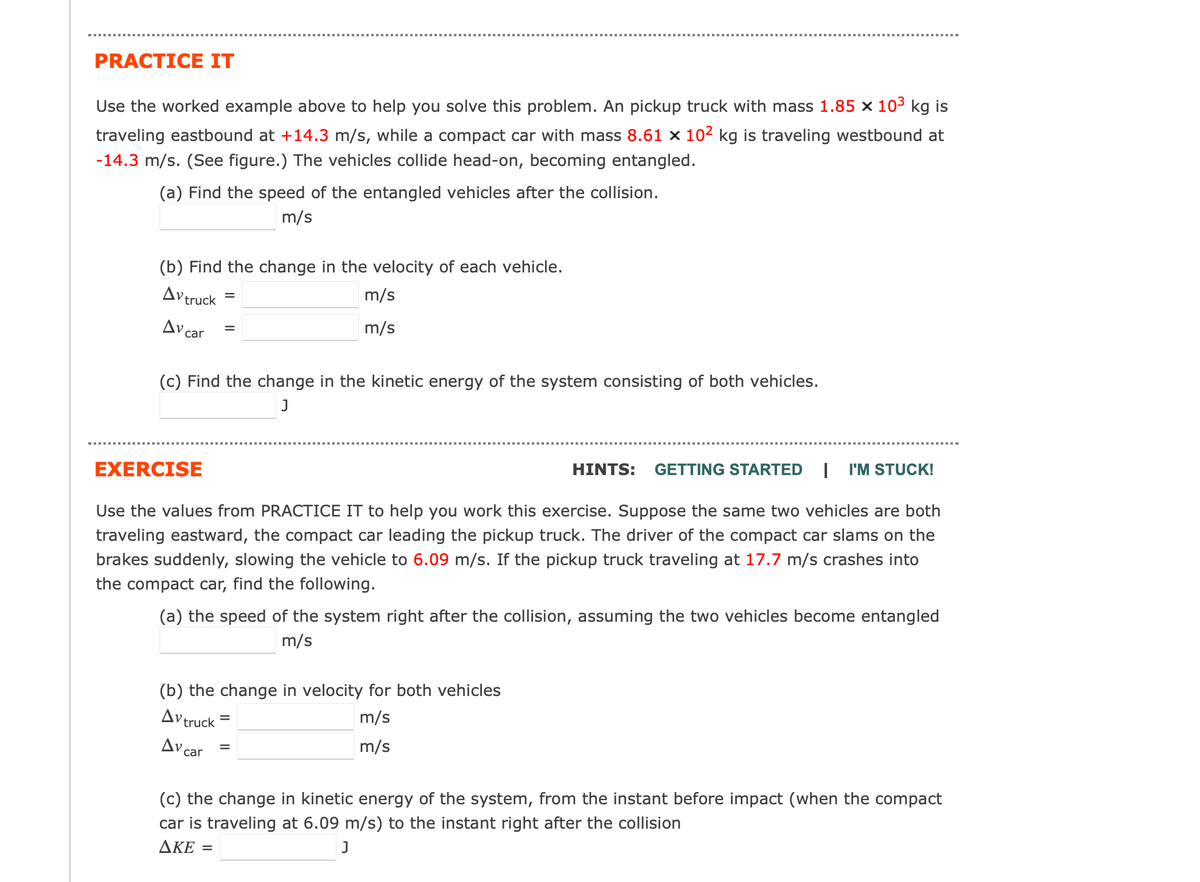PRACTICE IT Use the worked example above to help you solve this problem. An pickup truck with mass 1.85 x 10³ kg is traveling eastbound at +14.3 m/s, while a compact car with mass 8.61 x 102 kg is traveling westbound at -14.3 m/s. (See figure.) The vehicles collide head-on, becoming entangled. (a) Find the speed of the entangled vehicles after the collision. m/s (b) Find the change in the velocity of each vehicle. m/s Av truck Av car m/s (c) Find the change in the kinetic energy of the system consisting of both vehicles. J
PRACTICE IT Use the worked example above to help you solve this problem. An pickup truck with mass 1.85 x 10³ kg is traveling eastbound at +14.3 m/s, while a compact car with mass 8.61 x 102 kg is traveling westbound at -14.3 m/s. (See figure.) The vehicles collide head-on, becoming entangled. (a) Find the speed of the entangled vehicles after the collision. m/s (b) Find the change in the velocity of each vehicle. m/s Av truck Av car m/s (c) Find the change in the kinetic energy of the system consisting of both vehicles. J
Principles of Physics: A Calculus-Based Text
5th Edition
ISBN:9781133104261
Author:Raymond A. Serway, John W. Jewett
Publisher:Raymond A. Serway, John W. Jewett
Chapter8: Momentum And Collisions
Section: Chapter Questions
Problem 2OQ: A head-on, elastic collision occurs between two billiard balls of equal mass. If a red ball is...
Related questions
Topic Video
Question

Transcribed Image Text:STRATEGY The total momentum of the vehicles before the
collision, Pi, equals the total momentum of the vehicles after the collision, pf, if we ignore friction and
assume the two vehicles form an isolated system. (This is called the "impulse approximation.") Solve the
momentum conservation equation for the final velocity of the entangled vehicles. Once the velocities are
in hand, the other parts can be solved by substitution.
SOLUTION
(A) Find the final speed after collision.
Let m₁ and V₁¡ represent the mass
and initial velocity of the pickup truck,
while m₂ and V₂¡ pertain to the
compact. Apply conservation of
momentum.
Substitute the values and solve for the
final velocity, Vf.
Pi Pf
m₁v₁; + m₂V₂i = (m₁ + m₂) vf
Vf
(B) Find the change in velocity for each vehicle.
Change in velocity of the pickup truck.
Change in velocity of the compact car.
Calculate the final kinetic energy of the
system and the change in kinetic
energy, AKE.
(1.80 x 10³ kg)(15.0 m/s) + (9.00 × 10² kg)(-15.0 m/s)
(1.80 x 10³ kg + 9.00 × 10² kg)vf
+5.00 m/s
=
=
(C) Find the change in kinetic energy of the system.
Calculate the initial kinetic energy of
the system.
b
AV₁ = Vf - V₁i
AV₂ = VfV₂i = 5.00 m/s - (-15.0 m/s) = 20.0 m/s
KE₁ = 1/2m₁v₁/² + 1/2m₂v₂2²2
=
AKE
= 5.00 m/s 15.0 m/s =
=
(1.80 × 10³ kg)(15.0 m/s)²
+ (9.00 × 10² kg)(-15.0 m/s)²
= 3.04 x 105 J
VE
KE₁ = 1/(m₂ + m₂) v²
=
(1.80 × 10³ kg + 9.00 × 10² kg)(5.00 m/s)²
= 3.38 x 104 J
VE
-10.0 m/s
2.70 x 105 1

Transcribed Image Text:PRACTICE IT
Use the worked example above to help you solve this problem. An pickup truck with mass 1.85 x 10³ kg is
traveling eastbound at +14.3 m/s, while a compact car with mass 8.61 x 10² kg is traveling westbound at
-14.3 m/s. (See figure.) The vehicles collide head-on, becoming entangled.
(a) Find the speed of the entangled vehicles after the collision.
m/s
(b) Find the change in the velocity of each vehicle.
Av truck
Av car
=
(c) Find the change in the kinetic energy of the system consisting of both vehicles.
J
m/s
m/s
EXERCISE
HINTS: GETTING STARTED I I'M STUCK!
Use the values from PRACTICE IT to help you work this exercise. Suppose the same two vehicles are both
traveling eastward, the compact car leading the pickup truck. The driver of the compact car slams on the
brakes suddenly, slowing the vehicle to 6.09 m/s. If the pickup truck traveling at 17.7 m/s crashes into
the compact car, find the following.
(a) the speed of the system right after the collision, assuming the two vehicles become entangled
m/s
(b) the change in velocity for both vehicles
Avtruck
m/s
m/s
Av car
=
=
(c) the change in kinetic energy of the system, from the instant before impact (when the compact
car is traveling at 6.09 m/s) to the instant right after the collision
AKE =
J
Expert Solution
This question has been solved!
Explore an expertly crafted, step-by-step solution for a thorough understanding of key concepts.
This is a popular solution!
Trending now
This is a popular solution!
Step by step
Solved in 5 steps

Knowledge Booster
Learn more about
Need a deep-dive on the concept behind this application? Look no further. Learn more about this topic, physics and related others by exploring similar questions and additional content below.Recommended textbooks for you

Principles of Physics: A Calculus-Based Text
Physics
ISBN:
9781133104261
Author:
Raymond A. Serway, John W. Jewett
Publisher:
Cengage Learning

Physics for Scientists and Engineers, Technology …
Physics
ISBN:
9781305116399
Author:
Raymond A. Serway, John W. Jewett
Publisher:
Cengage Learning

College Physics
Physics
ISBN:
9781938168000
Author:
Paul Peter Urone, Roger Hinrichs
Publisher:
OpenStax College

Principles of Physics: A Calculus-Based Text
Physics
ISBN:
9781133104261
Author:
Raymond A. Serway, John W. Jewett
Publisher:
Cengage Learning

Physics for Scientists and Engineers, Technology …
Physics
ISBN:
9781305116399
Author:
Raymond A. Serway, John W. Jewett
Publisher:
Cengage Learning

College Physics
Physics
ISBN:
9781938168000
Author:
Paul Peter Urone, Roger Hinrichs
Publisher:
OpenStax College

Physics for Scientists and Engineers with Modern …
Physics
ISBN:
9781337553292
Author:
Raymond A. Serway, John W. Jewett
Publisher:
Cengage Learning

College Physics
Physics
ISBN:
9781305952300
Author:
Raymond A. Serway, Chris Vuille
Publisher:
Cengage Learning

College Physics
Physics
ISBN:
9781285737027
Author:
Raymond A. Serway, Chris Vuille
Publisher:
Cengage Learning